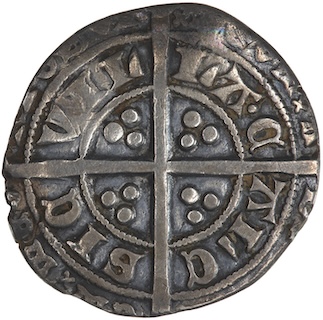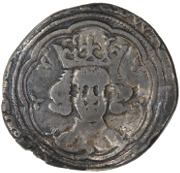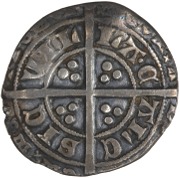
 1363-1369 Groat - Edward III (Calais Mint)
1363-1369 Groat - Edward III (Calais Mint)Heavily clipped Groat (4p) of Edward III struck between 1363 and 1369 at the Calais Mint (this is still classed as an English coin as at the time Calais belonged to England). Diameter 24mm, weight 3.73g. SCBC 1619, North 1258.
The Obverse shows a portrait of the King facing. Due to the clipping only the EDWA of the legend remains.
 The Reverse is a long cross with 3 pellets in each angle. Most of the outer legend is lost by clipping, the inner text is VIL LA C ALC SIC.
The Reverse is a long cross with 3 pellets in each angle. Most of the outer legend is lost by clipping, the inner text is VIL LA C ALC SIC.Image credit: Museums Victoria.
Mintage: Not known
Minted at Provincial mints
More information (monarch, year, mint, country, category) can be found below coin listings.
Below are some coins currently being offered on eBay. As an eBay Partner, We may be compensated if you make a purchase.
List items on:
List items on:
Remember 1363 ?
Monarch is Edward III. The Hundred Years' War (1337-1453) continues, often by Edward, the Black Prince (eldest son of Edward III). David II of Scotland agrees for Edward III to succeed him as King of Scotland. Edward III gives up claims to the French Throne in return for French land, including Calais.
Edward III (1327-1377)
Edward III ruled from 25 January 1327 until 21 June 1377, a reign of more than 50 years. He was considered a great military leader and made England one of the most powerful countries in Europe. Sometimes known as Edward of Windsor.Edward was born at Windsor Castle on 13 November 1312 to King Edward II and Isabella of France. Edward II was disposed in 1327 and Edward III became King at the age of 14. His mother Isabella and her lover Roger Mortimer initially ruled as Regent but at 17 Edward III established himself as ruler.
Edward married Philippa of Hainault and over the next 25 years had eight sons and five daughters. He outlived his eldest son, Edward the Black Prince (also a great commander), and the throne eventually passed to his grandson Richard II.
Edward III coins were initially based on the coinage of his Grandfather, King Edward I. The greater majority of Edward III coins are the penny, halfpenny and groat, but during his long reign he introduced several new coins. Gold coins appeared after 1344. The gold Edward III double-florin (double-leopard) is one of the rarest British coins as is the gold florin, both can obtain high six-figure evaluations. The early gold Noble is also up there.
Category: Groat
The Groat is an old coin worth four pence. It was found in England, Ireland and Scotland. The English Groat can be traced back to Edward I and was minted (not every year) up until Victoria although the fourpence coin is still minted today for use in Maundy sets.Which Mint: Provincial mints
Not all mints are located in a single place. From the Roman days through to the middle ages it was easier to have local moneyers (trusted people who were allowed to mint coins) rather than make the coins centrally and then have the security and logistics problem of distribution.There were often dozens of mints, sometimes all making the same coin. The variations and mintmarks are exciting for numismatists, although sometimes it takes an expert to analyse them.
Most English Provincial Mints began to close after 1279 when the Royal Mint opened The Tower Mint (called so as it was housed at the Tower of London), although some continued working for much longer. The central mint gave the King and the Master of the Royal Mint much more control over the production and quality of English coinage.
Country of Origin: United Kingdom
The United Kingdom (UK) is the Union of England, Scotland, Wales and Northern Ireland. It is often refered to as Great Britain (GBR). It has a long, rich history. The orignal coinage was Pounds, Shillings and Pence but since decimalisation on 15 February 1971, it is £1 = 100p, that is One Pound = 100 pence. The coinage of the UK is also a long history, the Royal Mint being established as long ago as 886AD when coins were hammered. Today there is perhaps 30 billion coins in circulation, and many (numismatic) collectors coins and sets are issued frequently in gold, silver and other metals.


![Edward III - Hammered Silver Groat - CIVITAS LONDON [MB]](https://i.ebayimg.com/images/g/jKQAAOSwgqdmpiS5/s-l225.jpg)




![KING EDWARD III HAMMERED SILVER GROAT [London] (#7312)](https://i.ebayimg.com/images/g/nD8AAOSwqPpn0zUA/s-l225.jpg)
